Heterogeneous Face Recognition as a Session Variability Problem¶
This section contains instructions on how to reproduce the experiments from Chapter 4 Heterogeneous Face Recognition as a Session Variability Problem.
Exceptionally, these instructions will cover only the Thermal database. This would avoid this section to be extremely large. However, the same set of instructions applies to ALL heterogeneous face databases. To see all the available databases, check:
$ resources.py --types database
List of registered databases:
- bob.bio.htface 1.0.0 @ <experiment>/bob.bio.htface:
+ casia-nir-vis-2 --> bob.bio.htface.configs.databases.casia_nir_vis: database
+ cuhk-cufs --> bob.bio.htface.configs.databases.cuhk_cufs: database
+ cuhk-cufsf --> bob.bio.htface.configs.databases.cuhk_cufsf: database
+ eprip --> bob.bio.htface.configs.databases.eprip: database
+ fargo --> bob.bio.htface.configs.databases.fargo: database
+ fargo_depth --> bob.bio.htface.configs.databases.fargo_depth: database
+ ldhf --> bob.bio.htface.configs.databases.ldhf: database
+ nivl --> bob.bio.htface.configs.databases.nivl: database
+ pola_thermal --> bob.bio.htface.configs.databases.pola_thermal: database
+ thermal --> bob.bio.htface.configs.databases.thermal: database
Thermal Experiments¶
The sequence of experiments in this subsection generates the necessary data that creates Figures 4.11. This covers the training using DCT coefficients and LBP histograms.
DCT Coefficients¶
The sequence of experiments in this subsection generates the necessary data to generate Figure 4.11 and Table 4.7.
First, the experiments should be generated:
$ bob bio htface htface_baseline isv_g64_u50 thermal -vv
$ bob bio htface htface_baseline isv_g128_u50 thermal -vv
$ bob bio htface htface_baseline isv_g256_u50 thermal -vv
$ bob bio htface htface_baseline isv_g512_u50 thermal -vv
$ bob bio htface htface_baseline isv_g1024_u50 thermal -vv
Once the experiments are executed, the plots and metrics can be generated with the following command:
$ bob htface evaluate_and_squash \
\
<experiment_path>/thermal/isv_g64_u50/ \
<experiment_path>/thermal/isv_g128_u50/ \
<experiment_path>/thermal/isv_g256_u50/ \
<experiment_path>/thermal/isv_g512_u50/ \
<experiment_path>/thermal/isv_g1024_u50/ \
\
--legends "64" --legends "128" --legends "256" --legends "512" --legends "1024" \
--report-name "thermal.pdf" \
--x-min 1 \
--title ""
If everything goes alright the following plot should be dumped
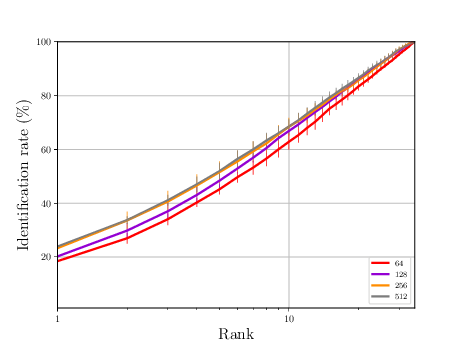
LBP Histograms¶
The sequence of experiments in this subsection generates the necessary data to generate Figure 4.11 and Table 4.7.
First, the experiments should be generated:
$ bob bio htface htface_baseline isv_g64_u50_LBP thermal -vv
$ bob bio htface htface_baseline isv_g128_u50_LBP thermal -vv
$ bob bio htface htface_baseline isv_g256_u50_LBP thermal -vv
$ bob bio htface htface_baseline isv_g512_u50_LBP thermal -vv
$ bob bio htface htface_baseline isv_g1024_u50_LBP thermal -vv
Once the experiments are executed, the plots and metrics can be generated with the following command:
$ bob htface evaluate_and_squash \
\
<experiment_path>/thermal/isv_g64_u50_LBP/ \
<experiment_path>/thermal/isv_g128_u50_LBP/ \
<experiment_path>/thermal/isv_g256_u50_LBP/ \
<experiment_path>/thermal/isv_g512_u50_LBP/ \
<experiment_path>/thermal/isv_g1024_u50_LBP/ \
\
--legends "64" --legends "128" --legends "256" --legends "512" --legends "1024" \
--report-name "thermal_LBP.pdf" \
--x-min 1 \
--title ""
If everything goes alright the following plot should be dumped
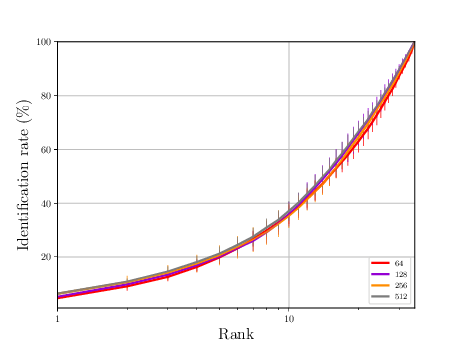
ISV Intuition¶
The ISV intuition showed in Figures 4.1 and 4.2 can also be plotted. This can be generated with the following command:
$ bob bio htface isv_intuition <OUTPUT_FILE.pdf>
If everything goes alright the following plots should be dumped
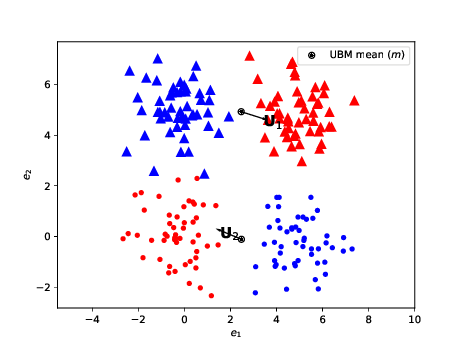
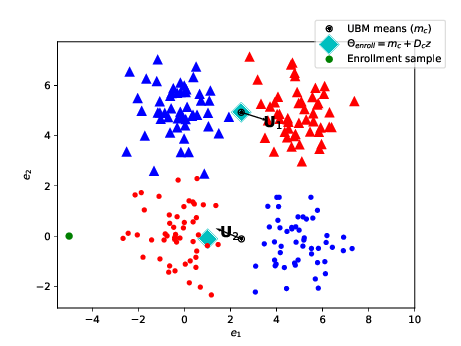
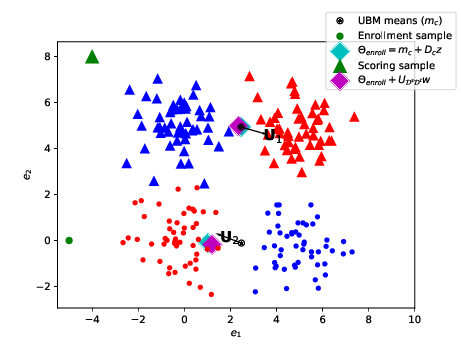

Relevant publications for this Section¶
- [pdf1] FREITAS PEREIRA, TIAGO, and SÉBASTIEN MARCEL. “Heterogeneous Face Recognition using InterSession Variability Modelling.” Proceedings of the IEEE Conference on Comput er Vision and Pattern Recognition Workshops. 2016.
- [pdf2] FREITAS PEREIRA, TIAGO, and SÉBASTIEN MARCEL. “Periocular biometrics in mobile environment.” Biometrics Theory, Applications and Systems (BTAS), 2015 IEEE 7th International Conference on. IEEE, 2015.